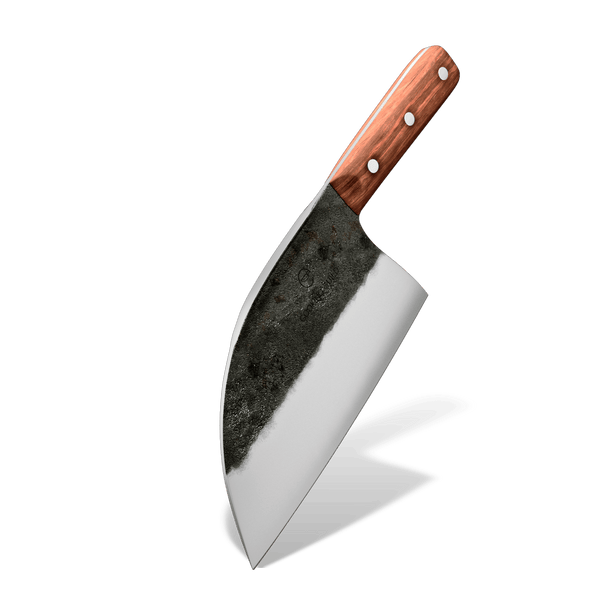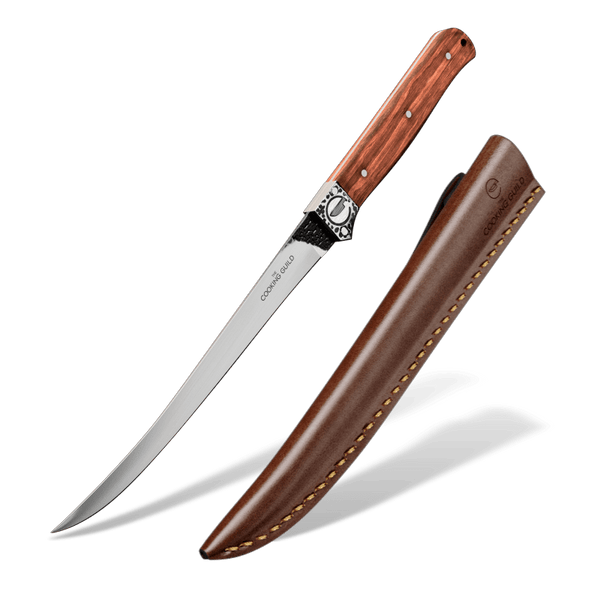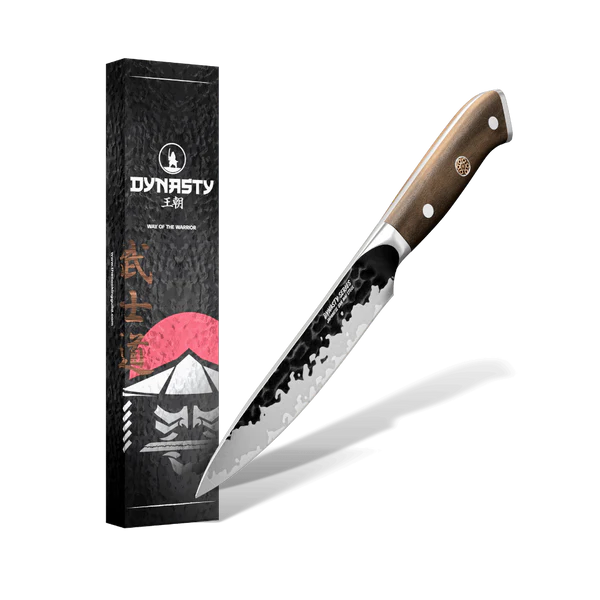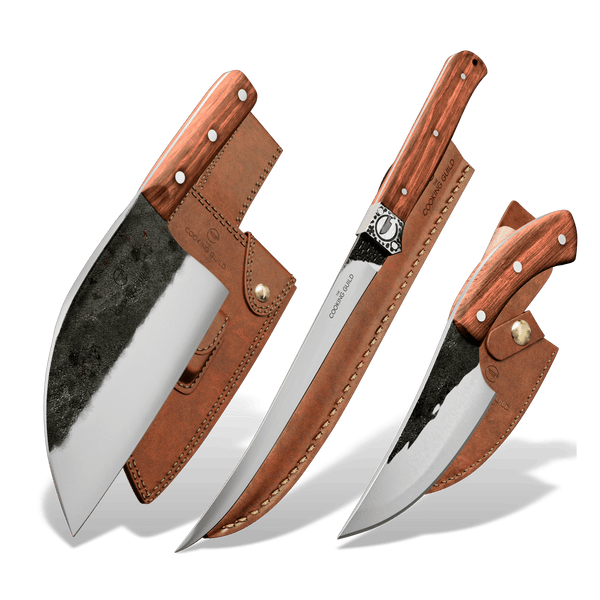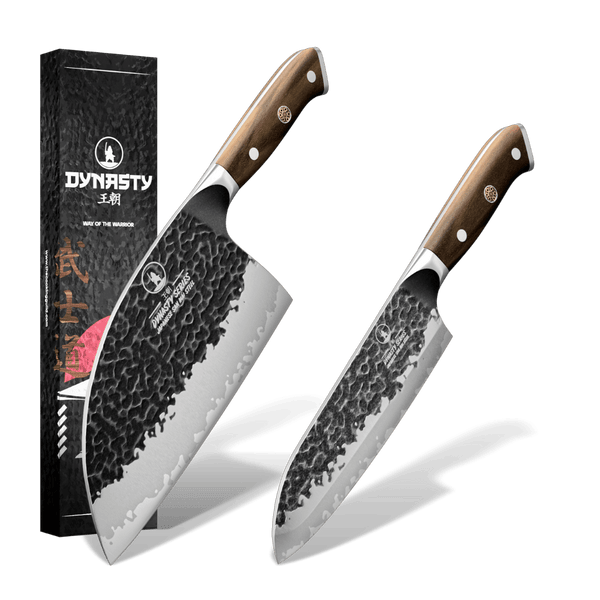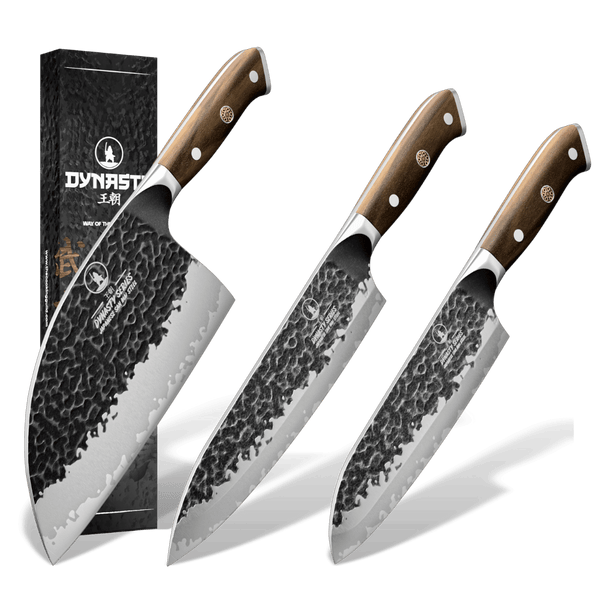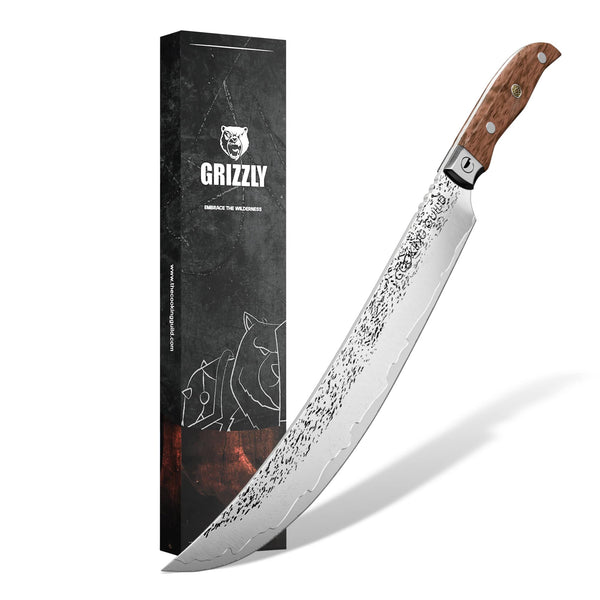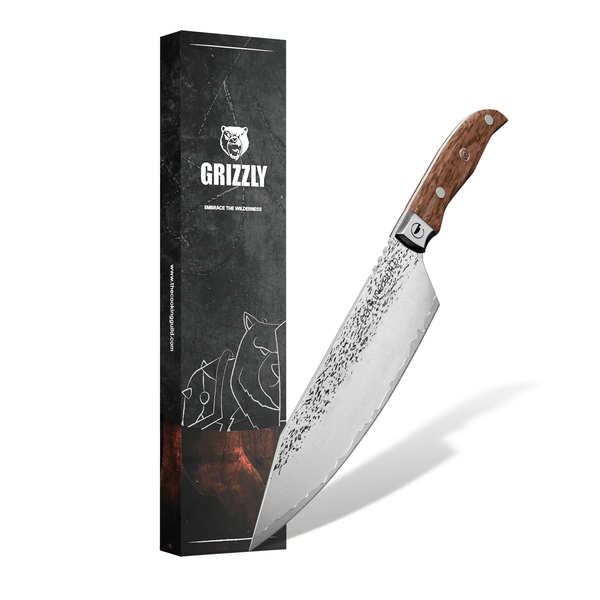Welcome to the world of steel knives, where the blade is more than just a cutting edge—it's a fusion of science and craftsmanship. Our latest blog post delves into the various types of steel knives, each alloy with its own story, characteristics, and slice of history.
From the rugged resilience of carbon steel to the rust-resistant ease of stainless, and the distinctive allure of Damascus, we'll explore what sets each type apart. Whether you're a culinary professional, an outdoor enthusiast, or a collector seeking the next addition to your array, understanding these steel types will sharpen your knowledge and help you make an informed choice for your blade companion.
Join us as we slice through the details and uncover the steel that shapes the essence of every knife.
Guide To The Best Knife Steel
The world of steel extends well past the well-known carbon and stainless steel classifications, and picking the type of steel for your knife boils down to your preference and what you plan to do with your knife.
Knife Steel Types: Comparing Their Properties, Uses, And Price
From Damasus Steel to Tool Steels to Premium and Low-End Steels, there are a seemingly infinite number of knife steel types. Like different toppings on a pizza, each has distinct properties, uses, and price tags.
From the affordable 420 stainless steel to the top-shelf VG-10, understanding the unique properties of each steel can help you identify a likely price and its ideal use.
How Much Does The Steel Of A Knife Matter
The quality of a knife's steel is paramount. Everything from balance, sharpness, and longevity are all impacted by the steel of the knife.
What’s The Difference Between Carbon And Stainless Steel And Some Stuff In Between
Carbon and stainless steel are perhaps the two most well-known steel names.
Stainless Steel contains a high chromium count (over 15%) and offers unmatched corrosion resistance. This blend of iron and chromium mineral composition creates a distinctive shininess.
Carbon Steel is an alloy of iron, carbon, and chromium (in lower counts than stainless steel) and is the preferred choice for many professional chefs and knife enthusiasts. It can be forged thinner and sharper than stainless steel, translating into a significantly more precise cut.
What Are Steel Standards
Steel standards, alternatively referred to as steel grades, offer a framework for categorizing, assessing, and determining the unique properties of various types of steel. The standards include composition, physical traits, thermal characteristics, and other metallurgical aspects. Steel standards define all carbon, structural, stainless, ferritic, austenitic, and alloy variations.
These standardized guidelines assist metallurgical labs and refineries to ensure they use premium steel in their products.
What Is Rockwell Hardness
Simply put, The Rockwell Hardness Scale measures how resistant a material is to permanent indentation - a higher number means harder steel. Harder steels can retain a sharp edge for longer, but it becomes more brittle.
Knives are measured for their hardness on the Rockwell scale through a two-step process. Essentially, the procedure involves applying a small preliminary force, known as a minor load, and then an additional force, known as a major load.
- A minor load is first applied to the knife's blade using a diamond cone (for harder materials) or steel ball indenter (for softer materials). This establishes the zero point on the scale.
- Then, a major load is applied. Once this major load is removed, maintaining the minor load allows a deep permanent impression on the material.
The depth of penetration from the zero point up to this indented mark determines the Rockwell hardness number. A lower penetration signifies a higher Rockwell number and hence, indicates a harder material.
Average Rockwell Hardness By Knife Type
The hardness of a blade varies depending on its purpose. Axes, for example, have an HRC of 40-50, while an ultra-sharp chef's knife is around 55-60 HRC.
What Is Powder Steel
Powder steel, or Powder metallurgy, is a process of producing metal components by heating and refining alloys into a metallic powder. The powder is blended with other metals to achieve the desired material properties and characteristics for a particular steel.
The Five Key Properties Of Knife Steel
With so many types of steel on the market, how do the experts know which one to use for kitchen knives? Well, they often rate them on the following five properties.
Hardness
Hardness is the bedrock of a kitchen knife's performance - the harder the steel, the sharper the edge, making it scythe through ingredients effortlessly.
Toughness
Toughness shields your knives from chipping and breaking. While you want a thin and sharp blade, you don’t want something flimsy and susceptible to cracking.
Wear Resistance
A good knife should last a long time. Therefore, knife makers value steel that remains sleek and sturdy for years.
Corrosion Resistance
Corrosion and oxidization will naturally occur in carbon blades. Exceptional steel offers a degree of corrosion resistance without sacrificing sharpness.
Edge Retention
Edge retention is how long a knife can maintain its razor-sharp edge. When looking for kitchen knife steel, edge retention is the trait that separates your favorite chef knife from a dull butter spreader.
Heat Treatment
Heat treatment for steel involves heating and cooling the metal to change its physical properties, enhancing characteristics like hardness, toughness, strength, and resistance to wear.
Sharpenability
Finally, a highly-regarded type of steel will be easily sharpened using a whetstone, honing rod, or a sharpening block. Bonus points if it does not have to be sharpened often.
Common Knife Steel Types
We're cutting right to the chase and breaking down the most common types you'll find in the kitchen or your pocket. From the tough and sharp carbon steel to the shiny and strong stainless steel, and the fancy-looking Damascus with its cool patterns, each kind has its special features. Whether you're cooking dinner, going camping, or just need a handy tool, knowing about these steel types helps you pick the right knife for the job. Let's get started and find out what makes each knife steel tick!

Plain Carbon Steels
Plain Carbon steels are some of the most common knife steels in the world. Devoid of extravagant alloying elements, they consist of a minimum of 0.7% carbon, making them exceptionally sharp.
1075
1075 steel offers excellent malleability for forging intricate shapes. It contains 0.75% carbon, which makes it stand on the balance beam between hardness and resilience flawlessly. Ideal for a bushcraft knife, its ability to withstand external forces is remarkable.
1084
The 1084 steel is your sturdy old-school workhorse. Its composition with about 0.80-0.90% carbon ensures impressive hardness without compromising the necessary flexibility. It also possesses Iron, Manganese, Phosphorus, and Sulfur.

Alloy Steels
Alloy steel, a distinct type of steel, is composed of blending multiple elements with steel, referred to as 'alloying elements'. These elements bolster the steel's properties, providing more hardness, resilience, wear resistance, and toughness, resulting in a sturdier and more dynamic form of steel.
Typically, these alloying elements make up less than 5% of the overall steel material.
Alloying Elements and Their Impact on Blades
The quality, durability, and performance of a blade are heavily influenced by the alloying elements present in its composition. Here are some common elements used in knife steel:
- Carbon: An essential component of steel, it increases sharpness and decreases the weight of the blade. However, higher carbon makes the steel more susceptible to corrosion.
- Chromium: Chromium enhances a blade's wear resistance, tensile strength, and toughness. It gives steel its stainless properties by forming a passive layer that prevents corrosion.
- Molybdenum: Another mineral used to bolster steel's resistance to both corrosion and brittleness at high temperatures, significantly enhancing toughness.
- Vanadium: This element refines the steel's grain structure to provide superior edge retention.
- Nickel: Nickel improves the overall strength and toughness of the blade.
By understanding these elements' impacts on blades, crafters can adjust steel to achieve the perfect balance for specific uses. From kitchen knives to outdoor survival blades, these small elemental changes can make all the difference in performance.

Tool Steels
Tool steels are a category of carbon and alloy steels recognized for their hardness, abrasion resistance, and ability to hold a cutting edge at high or cool temperatures.
The specific composition varies but generally contains around 0.5-1.5% carbon for hardening and tempering purposes, with various additional alloying elements like chromium, molybdenum, vanadium, and tungsten for enhanced toughness, heat resistance, and wear resilience.
Tool steels are rugged and fit for power-driven tools, including drill bits.
O1
With 0.90% Carbon, 1.2% Manganese, and 0.5% Chromium and Tungsten each, O1 steel steals the show by offering precise hardness without limiting shock absorption, making it the go-to choice for woodworking hand tools.
A2
A2 steel stirs the pot by adding more chromium than O1 (up to 5%). This chemical change results in a sizeable leap in toughness and wear resistance, making it ideal for hammers and other heavy-duty tools.
52100
The 52100 has ~1.0% carbon, ~1.5% chromium, and trace amounts of phosphorus and sulfur, creating steel delivering top-notch toughness and malleability. 52100 steel is often used for bearings, tubes, and vehicle parts.
3V
With a mixture of .8% carbon, 7.5% chromium, and a sprinkle of vanadium (~2.5%), the 3V steel possesses high impact strength and good wear resistance. Many consider it one of the strongest steels. 3V is used for tools and kitchen knives.
4V
Similar to 3V steel but boosted with 0.4% Tungsten, 0.40% Manganese, and 2.95% Molybdenum, 4V steel provides a long-enduring edge perfect for knives that demand intense resilience.
W1
W1 steel is a type of high-carbon steel (0.8% to 1.5%) with trace amounts of Nickel, Manganese, and Vanadium. It is one of the few steels hardened by water and is often used for blacksmithing tools.
Cruwear
Cruwear steel has a great blend of elements, making it a well-rounded steel that is easily sharpened. It is heat-treatable and has a high hardness rating (60+ HRC). These properties make it suitable for kitchen and EDC knives.

Stainless Steels
Stainless steels are known for their oxidisation-resistance properties. Stainless steels contain at least 10.5% chromium and more than 8% nickel. Certain types of stainless steel may also possess other elements, such as vanadium, to obtain the desired properties.
420 Steels
With 0.15-0.3% Carbon and 12-14% Chromium, 420 steel provides optimal hardness and beautiful stainless properties. With its tensile strength, 420 steel is ideal for heavy-duty food processing equipment.
8CR13MOV
8CR13MOV steel is a Chinese steel known for its affordability and durability. With a great blend of carbon, chromium, and vanadium, 8CR13MOV is incredibly resistant to wear and corrosion. It's commonly used for low-end knives and scissors.
AUS-8
AUS-8 steel balances low carbon content (0.75%), high chromium (10%+), and a mixture of manganese, molybdenum, and vanadium, making it easy to sharpen. This trustworthy steel is often found in EDC (Everyday Carry) knives that must remain sharp and ready for any task.
AEB-L And NITRO-V
AEB-L steel is a commonly used stainless steel that contains roughly 1% carbon and 13.5% chromium. Meanwhile, the NITRO-V is very similar to AEB-L but with small amounts of Vanadium and Nitrogen to it. Both are ideal for thin but incredibly sharp blades.
CPM154
With ~1.4% Carbon and 14% Chromium, CPM15 is an all-rounder by offering enhanced hardness and commendable stain resistance alongside high toughness. Suitable for scissors that need to cut through a myriad of household items seamlessly.
S45VN
S45VN is crucible steel that boasts resilience and strength thanks to over 1.4% carbon and +15% chromium. This steel is known as a high-end stainless steel for high-end kitchen and pocket knives.
CTS-204P
CTS-204P is created through the Powder Metallurgy process. This steel is high in vanadium, chromium, and carbon. CTS-204P is used for high-performance industrial, military, and law enforcement applications that require steel that can withstand any element.
Magnacut
Magnacut is the polymath of knife steels, showing excellent prowess in corrosion resistance and edge retention along with good strength, thanks to 4% Vanadium and 2% Molybdenum. This steel is perfect for survival knives and high-end cutlery applications.
AUS-10
Aus-10 is one of the premier knife steels on the market, with a balanced composition of high Carbon (over 1%), Chromium (over 13%), and Molybdenum (over 0.10%). With its exceptionally sharp edge, it is ideal for cutting meat or filleting fish.
X50CRMOV15
X50CRMOV15 is a premium German knife steel that is resilient against rusting and provides tremendous sharpness. The name outlines part of the metal composition, with the x50 representing more than 50% steel, the CR indicating Chromium, the M indicating Molybdenum, and the V for Vanadium. The 15 at the end refers to the amount of chromium in the steel.
1.4116
1.4116 is another name for X50CRMOV15, and the chemical composition is the same. Both steels are used for cutlery, outdoor knives, and much more.
Cromova 18
The Cromova 18 flaunts high amounts of Chromium, Molybdenum, and Vanadium, ensuring it maintains an ultra-sharp edge and unparalleled resistance to weather and wear.
The 18 at the end of the name refers to the percentage of chromium in the blade. Cromova 18 is dense, easy to sharpen, and suitable for any application.
Friodur
Friodur is not just steel; it's a sturdy ice-hardened version of 440C steel that provides supreme edge retention and strength. This type of steel is rare but is worth the effort to find, as the sharpness and durability are unmatched.
Sandvik 12C27
Sandvik steels are highly regarded in the world of knife making. It contains a low amount of carbon (less than .7%) and an average amount of chromium (Usually 13.50%). This mineral composition makes it a low-end stainless steel perfect for boning knives that require sharpness, precision, and durability.

Damascus Steel
Damascus steel, also known as pattern-welded steel, differs significantly from stainless steel thanks to its unique forging process and higher carbon count. Damascus steel is amongst the sharpest in the world and is commonly used for luxurious kitchen knives.

Ceramic Blades
Ceramic blades, contrary to their name, aren't forged from earthen clay. They are also not formed from steel. Instead, they contain zirconium oxide, a compound harder than steel. Its toughened physique and unparalleled sharpness make it an ideal steel for chef knives or cleavers.

Titanium Blades
Titanium steel is used in numerous applications thanks to its robust strength and durability. When it comes to knives, titanium blades offer one of the best weight-to-sharpness ratios, allowing blade makers to create comfortable and exceptional knives.
Stellite 6-K
Stellite 6-K is a Cobalt-based alloy with chromium, carbon, nickel, Tungsten, and iron. With over 25% chromium and numerous carbides, Stellite 6-K is one of the hardest steels in the world.
Exotic Steels
Exotic steels feature unique elements such as Tungsten, Vanadium, or Molybdenum. These steels are most often used for high-end and collector's items.
LC200N
LC200N is a chef's dream, with high toughness and extraordinary corrosion resistance delivered by a unique Nitrogen, Chromium, and 1.00% Manganese combo. Due to its corrosion-resistant properties, it is used in kitchens, chemical processing plants, and pharmaceutical industries.
K390
K390 is manufactured through powder metallurgy and features a unique alloy composition, including Carbon, Chromium, Vanadium, and Molybdenum. What separates this composition from other knives is the large amount of Vanadium (9%) and Molybdenum (3%). K390 is used for heavy-duty industrial applications.
Aogami / Blue Paper Steel
Blue Paper Steel, also recognized as Aogami, is an exquisite Japanese steel that is used for swords and kitchen knives. With its blend of carbon, chromium, tungsten, and manganese. It boasts a score over 60 on the Rockwell Hardness Scale. The marriage of such traits makes Aogami ideal for sashimi-grade fish.

Ultra High-End Steel Types
Ultra-high-end steel features a higher percentage of carbon than stainless steel. These blades are often some of the sharpest on the market, making them suitable as chef knives.
CPM S110V Steel
The CPM manufacturing process is detailed and focused on the careful and uniform mixing of different minerals. Some of the unique properties of CPM S110V Steel include 2.8% carbon, 9% vanadium, and 3% Niobium, which delivers incredible hardness while maintaining an impressive edge longevity.
CPM S90V Steel
CPM S90V Steel is a high-grade martensitic steel with a blend of Carbon (2.3%) and Vanadium (9%). The allure of CPM S90V steel is the increased amount of vanadium carbides, which minimizes oxidization that the carbon is susceptible to.
M390 Steel
M390 ticks all the boxes for ideal knife steel – high toughness, wear resistance, and impressive corrosion resistance. It’s perfect for your everyday carry knives due to consistent performance despite repeated use.
M398 Steel
M398 Steel is a newer high-carbon steel featuring a dash of Tungsten, Vanadium, and Molybdenum.
One of the impressive features of M398 steel is it maintains its hardness under high heat (over 400 degrees Fahrenheit) thanks to 25% chromium carbide and 5% vanadium carbide.
M398 offers impeccable wear resistance and is suitable for knives and equipment used for intense military operations that require consistent performance in demanding conditions.
ZDP-189 Steel
Crafted in Japan and designed to deliver exceptional hardness, ZDP-189 Steel is a highly regarded steel. With an HRC scale of 66-67, this steel maintains razor sharpness for months without sharpening. ZDP-189 Steel is used in high-end Santoku knives.
Elmax Steel
Elmax is a high-end and exquisite blend of steel manufactured through powder metallurgy. It contains Chromium, Molybdenum, and Vanadium, minimizing impurities and ensuring razor sharpness.
CPM-20CV Steel
Adorned with Chromium, Vanadium, and Molybdenum, CPM-20CV steel offers fantastic wear resistance and robust corrosion resilience. This chemical composition is a perfect match for everyday chef knives that require a lightweight but sharp blade to achieve any cut.

Knife Steel-Premium
Premium knife steels often include Celestial Titanium, Zirconium, or Nickel alloys – creating blades with astonishing edge retention and durability.
CTS-XHP Steel
CTS-XHP is a high-carbon (over 1%), high-chromium (over 16%) air-hardened steel that strikes the perfect blend of strength, sharpness, and corrosion resistance. Due to its exceptional sharpness, CTS-XHP Steel is commonly used for carving knives.
CPM M4 Steel
With 1.4% carbon and only a trace of chromium (3%), CPM M4 Steel is one of the premier high-carbon knife steels on the market. It relies on Vanadium and a molybdenum core to protect the carbon from oxidization.
CPM S35VN Steel
CPM S35VN Steel leverages Niobium’s magical nanoparticles to brittleness while containing a remarkable 1.4% carbon content. Many believe it retains its edge better than any steel on the market, making it an ideal steel for top-end chef knives.
CPM S30V Steel
CPM S30V is a popular supersteel thanks to its stain-resistant and corrosion-resistant properties. Aided by vanadium carbides, CPM S30V Steel can withstand almost anything and is commonly found in the finest survival knives.

Knife Steel-High End
High-end knife steels like D2 and VG10 are synonymous with superior edge retention, toughness, and corrosion resistance.
154CM Steel
A blend of Carbon (1.05%), Molybdenum (4%), Iron (80%), and Chromium(14%) gives 154CM its reputation for high hardness, remarkable toughness, and excellent corrosion resistance. It's an all-around steel for cleavers, bread knives, boning knives, utility knives, and everything in between.
ATS-34 Steel
ATS-34 Steel is a popular high-end knife steel due to its availability and ease of heat treatment. Similar to 154CM steel, this rugged steel is strong and can handle heavy-duty tasks, making it suitable for cleavers and hunting knives.
D2 Steel
With a unique composition of 12% chrome and 1.5% carbon, D2 Steel is renowned for its incredible opposition to wear and superior edge retention. Its high carbon content creates a robust resistance to abrasion and wear, all while providing excellent sharpness that every cook dreams of.
VG-10 Steel
VG-10 steel is a Japanese steel widely recognized in professional culinary circles for its exceptional hardness yet flexibility. With a mineral composition of 1% carbon, 15% chromium, 1% molybdenum, 0.2% vanadium, 1.5% cobalt, and 0.5% manganese, it achieves the perfect balance of durability and edge-holding capability.
H1 Steel
H1 Steel ticks all the right boxes for kitchen blade material. It offers a unique composition with 0.9% Carbon and a high level of Chromium at 15%. It also contains trace amounts of Nitrogen, adding to its strength and providing extra rust resistance.
N680 Steel
Composed primarily of carbon, chromium, nitrogen, and molybdenum, N680 steel boasts phenomenal corrosion resistance. Thanks to its high corrosion resistance, it's perfect for those who frequently cook with acidic fruits and vegetables or moist ingredients like fish.
N690 Steel
N690 Steel is unique for its cobalt content (1.5%), along with carbon, chromium, and molybdenum. Cobalt amplifies the steel's strength while the vanadium provides excellent wear and rust resistance.
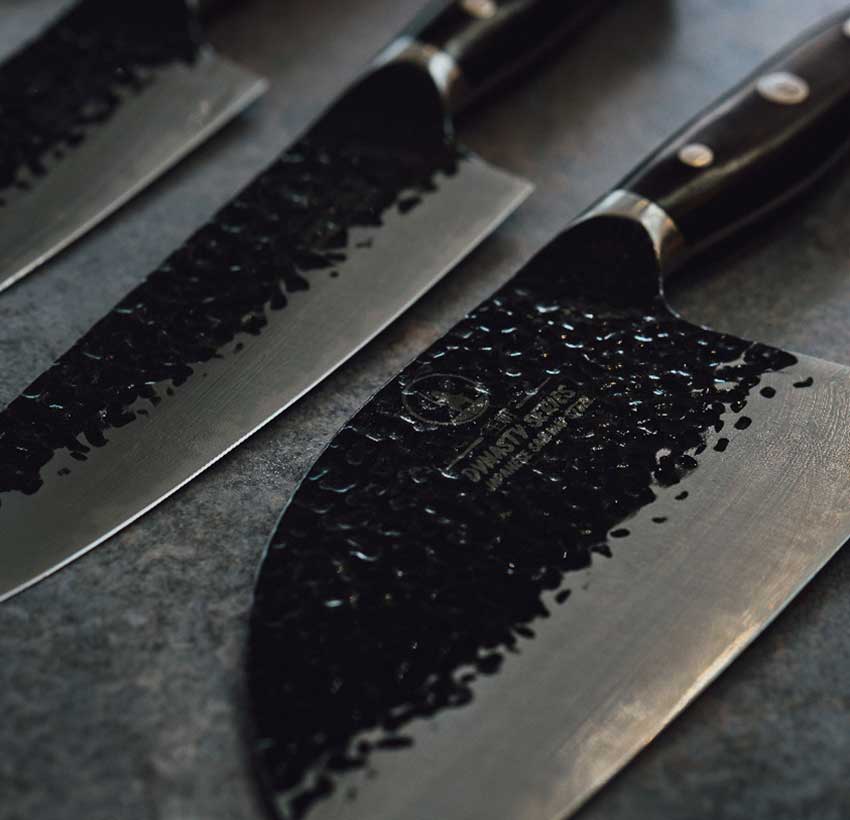
Knife Steel-upper Mid Range
Upper Mid-range steels like 440C and CTS-BD1 uphold a striking balance between hardness and toughness without costing as much as high-end steels.
440C Steel
440C Steel contains around 1.0% carbon (the highest of the 400 series) and up to 18% chromium, which gives it superb hardness (58+ HRC) and corrosion resistance. This type of steel is best for carving thick cuts of meat.
Bohler N695 Steel
Bohler N695 is a German steel with 1.10% carbon, 17% chromium, and traces of elements like molybdenum and silicon. Bohler N695 steel delivers exceptional hardness and corrosion resistance.
CTS-BD1 Steel
CTS-BD1 Steel contains carbon, chromium, silicon, and manganese, with traces of vanadium. Thanks to its nitrogen properties, the blade edge is much finer and less prone to chipping. This steel is found in all types of knives, from cleavers to paring knives.
14C28N Steel
This Swedish steel blends carbon, chromium, silicon, manganese, and a pinch of nitrogen. The steel's best feature is its sharpness and resistance to corrosion. Thanks to its low-maintenance nature, 14C28N Steel can be used for everything from cutlery to EDC knives.
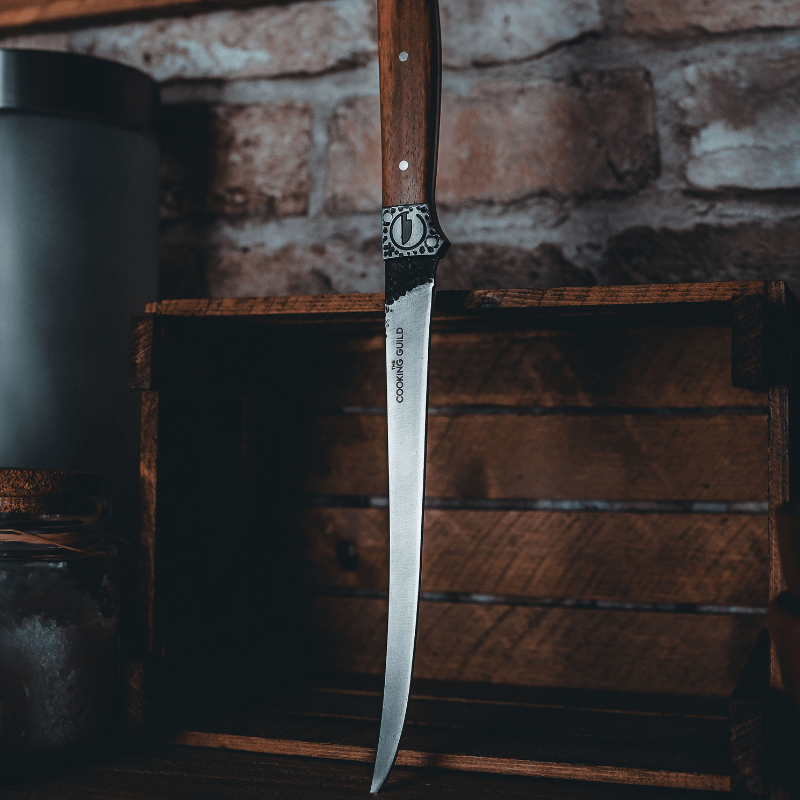
Knife Steel - Lower Mid-range
Lower mid-range knife steels, such as 440A or 420HC, are durable but provide slightly lower performance on the edge retention and toughness fronts.
440A Steel
440A Steel utilizes similar components to its close relative - the 440C but with less carbon content (0.55%). While it may compromise slightly on hardness, the trade-off is stellar corrosion resistance.
420HC Steel
420HC Steel is a mix between 440A and 440C, employing lower carbon content (0.45%) than 440A and proportional amounts of chromium. 420HC offers a fine balance of hardness and corrosion resistance at a lower-end price range and possesses an ideal elemental makeup for everyday chef knives.
13C26 Steel
13C26 Steel is a martensitic known for its edge stability, making it a great steel for cleavers and long blades. Even though the blade contains ample chromium (13%), the blade is heat-treated to improve wear resistance.
1095 Steel
Boasting a rich carbon content, 1095 steel is renowned for its hardness, and sharpness, offering precise slicing power to anyone who wields a 1095 steel blade. 1095 Steel is a reliable companion for bushcraft blades that rely heavily on constant sharpness for survival tasks in the wilderness.
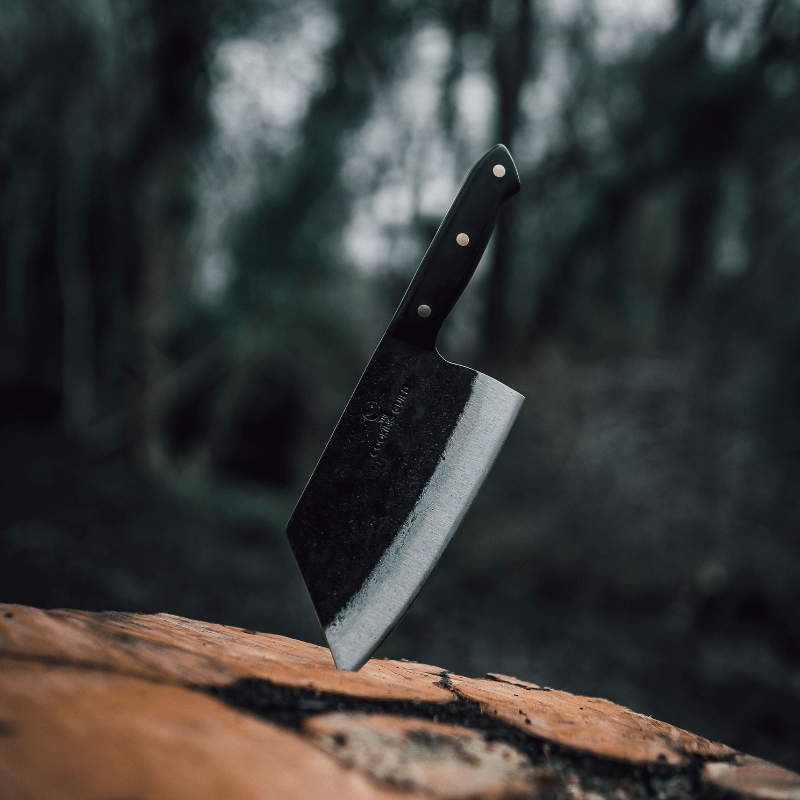
Knife Steel-low End
Low-end Knife steels find their niche in affordability and ease of maintenance. However, make no mistake, as these steels can still perform exceptionally well.
420J Steel
Comparable to 420HC but with lesser carbon content (0.15%), 420J Steel provides admirable corrosion and wear resistance despite being softer. It is best for lighter cutting tasks; handling soft fruits or peeling vegetables highlighted its dexterity without causing any damage.
AUS-6 Steel
With a mild amount of carbon (0.55%) and relatively high chromium (13%) content, AUS-6 steel strikes a balance between hardness, ample tensile strength, and corrosion resistance properties at affordable prices.
AUS-4 Steel
Equipped with lesser carbon (0.45%) than its brethren but supplemented with extra Chromium (14.5% vs. 13%) for anti-corrosion, AUS-4 is a long-lasting and durable steel commonly used for entry-level kitchen knives or in everyday household cutlery set.
Other Popular Steels
Some popular steels do not fit into any of the above classifications. These include Maxamet, Cruwear, and CPM-Magnacut steel.
Maxamet
Maxamet is one of the best steels on the market. With a remarkable 2% carbon, 13.00% tungsten, and 6.00% Vanadium, Maxamet has some of the smoothest grain and hardest carbides of any knife. Any knife possessing Maxamet steel will be of exceptional quality.
Cruwear
Cruwear is another premium high-carbon knife, containing over 1% carbon, 2.4% vanadium, 1.15% tungsten, and 1.5% Molybdenum. This blend of alloy minerals reduces the amount of chromium required (7%), creating an incredibly hard, sharp, and durable blade.
CPM-Magnacut
CPM-Magnacut is one of the most recent breakthroughs in steel making. According to a CATRA study, it is one of the top knife steels in sharpness, corrosion resistance, and overall strength.
Knife Steel Performance Charts
In our opinion, we’d rank the performance of the knife steels we discussed as follows.
- CPM S110V Steel
- M398 Steel
- ZDP-189 Steel
- CPM S90V Steel
- M390 Steel
- Maxamet
- CPM S35VN Steel
- CPM-20CV Steel
- K390
- Elmax Steel
Steel Popularity
Popularity is not easy to quantify, but if we had to rank these steels in terms of how common we can find them, the list would be as follows:
- Stainless Steels
- Damascus Steel
- VG-10 Steel
- D2 Steel
- AUS-8 Steel
- 1095 Steel
- O1 Steel
- CPM S35VN Steel
- M390 Steel
- 420HC Steel
Knife Steel Elements
Knife steels are composed of several elements, each providing different characteristics:
- Carbon (C): generally increases hardness, thus improving edge retention and wear resistance.
- Chromium (Cr): enhances corrosion resistance and influences hardness.
- Molybdenum (Mo): improves strength, hardness, and wear resistance.
- Manganese (Mn): contributes to hardness and wear resistance, while also improving forgeability.
- Vanadium (V): boosts hardness and wear resistance while reducing grain size for a sharper edge.
- Nickel (Ni): adds toughness to the steel, making it less brittle.
- Tungsten (W): it helps improve hardenability and wear resistance.
These elements come together in varying proportions in different types of steels to provide optimal performance depending on the specific requirements of the knife’s application.
Other Considerations
While it’s important to know what the best types of knife steels are, one of the critical considerations is availability. If you cannot buy CPM steel close by, then adjustments have to be made.
Another aspect to consider is manufacturing and processing time. If you need to steel quickly, it would be wise to choose a common type of steel, such as the 420 series.
The Best Knife Steels For Each Job
With varying elemental properties, each knife steel is made for a specific task. When finding the best knife steel for each job, you must also consider its usage.
Steels For Kitchen Cutlery
We believe the ideal kitchen cutlery set is easy to clean, corrosion-resistant, strong, and sharp enough to cut through meat and seafood. Therefore, we would pick 8CR13MOV or AEB-L, as they showcase all the hardiness and durability required for everyday use. Another bonus is that these steels are easy to steel.
Steels For Budget Knives
Ordinary does not necessarily mean ineffective— and the humble 440C is a testament to that. This cost-effective steel is dense (HRC 60) and rugged. Although it may not hold a candle to other high-end steels in carbon purity, it boasts solid hardness and consistent corrosion resistance.
Steels For Bushcraft And Survival Knives
For Bushcraft knives, we’d recommend Cruwear, 4V, and Magnacut. These knife steels possess balance, toughness, and wear resistance. These steels last for years and will provide you with a trustworthy knife.
Frequently Asked Questions
What Steel Is Used For Knives?
All the types of steel we listed can be used in knives. From 1045 in budget-friendly EDC knives to VG-10 steel in chef knives, the steel in knives around us varies far more than most people expect.
What Are CPM Steels?
Compact Powder Metallurgy (CPM) is a metal-forming process in which powdered minerals are heated just below their boiling point. This process creates incredibly dense steel that provides industry-leading performances in wear and rust resistance and edge retention.
Austenitic Vs. Martensitic Steel
In the world of knife steels, the terms Austenitic and Martensitic are both used to describe types of knife steels. However, each features a distinct mineral composition and use case.
Austenitic Steel, high in chromium and nickel, boasts excellent corrosion resistance and is often used for cutlery in marine applications.
On the other hand, Martensitic Steel is packed with carbon, which gives it strength and hardness.
Are All Blades From The Same Steel Alike?
Even if blades are forged from the same steel, performance can differ significantly.
For instance, two blades made of 416 stainless steel can vary due to different heat treatments applied by blacksmiths during forging - thereby altering the steel's hardness and durability.
Is D2 better than 440C?
Both have differing mineral compositions and advantages. D2 steel contains high carbon and less chromium, making it incredibly hard, sharp, and ideal for heavy-duty food processing tasks.
Conversely, 440C contains less carbon but more chromium, which provides excellent corrosion resistance, suiting it perfectly to marine food preparation conditions.
Is G10 steel good?
G10 is not real steel but a high-pressure fiberglass laminate. Its immense strength, lightweight, and moisture resistance make it an excellent choice for knife handles.
What Knife Steel Is The Sharpest?
Any high-carbon knife will have exceptional sharpness. In our opinion and testing, we found that Japanese VG-10 steel consistently has a sharp edge.
The frequency or sharpening and the technique also influence the sharpness of any steel.
What Is The Strongest Steel Used For Knives?
When talking about strength, we look at ZDP-189 steel. This Japanese steel has high levels of carbon and chromium to create an extraordinarily hard blade, with a hardness of 64-67 HRC.
This strength makes ZDP-189 resistant to abrasion and ideal for slicing through dense materials like winter squash without damaging the blade.
